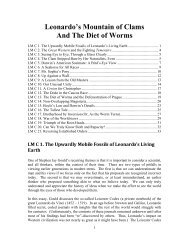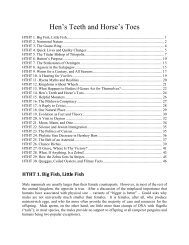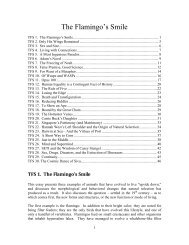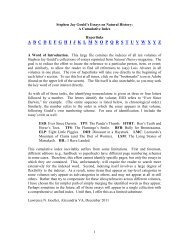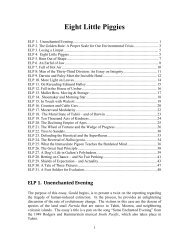type of soil, amount of rain, and so on) but were not regional. <strong>In</strong> the late 1960’s and early1970’s, a young <strong>Stephen</strong> <strong>Jay</strong> Gould sought to resolve this issue with the technique ofmultivariate analysis, recently made feasible by the advent of affordable computing [seeTFS 11]. Multivariate analysis is simply the technique of comparing many differentphysical variables (in this case, measured snail shell dimensions) against each other andto look for patterns and relationships. Gould was successful, in that he was able toidentify certain features that did indeed vary regionally, and others that varied by localcondition; that is, he found that both previous studies were partially correct. However, hestates, his original motivation was to hone his multivariable analysis skills on therelatively simple case of Curacao, and then move on to the vastly more complex case ofthe Bahamas, where there were many species and vastly more variety. <strong>In</strong> this, he was notsuccessful, in that he was not able to extrapolate his technique. Curacao was not merely asimplified version of the Bahamas, when it came to varieties of Cerion; the interactionsof the Bahaman species with each other led to emergent patterns that could not beignored.He closes by noting that his most recent trip to Curacao, and his motivation for writingthis essay, was to help celebrate the 70 th birthday of Benoit Mandelbrot, one of thefounders of fractal geometry. One of the classic examples of this field is that the lengthof a coastline (traditionally England’s) is a function of the scale at which you measure it.If you measure at the scale of a grain of sand, the coastline may be almost infinite; thelarger the minimum size of the one considers, the smaller will be the sum of the pieces.That is, the scale matters; “large” is not always a big “small,” and “complex” is notalways a former, identifiable “simple.” The essay’s title probably refers to his storytellingapproach regarding snails and fractals, but “speaking” could refer to his discussionof languages.DIH 28. Hooking Leviathan by Its PastThere were a series of exciting fossil whale discoveries in the 1980’s and 1990’s, whichGould discusses here. The record that we have, as a result of these discoveries, clearlyshows a series of discrete steps between land-dwelling ancestors and marine descendents,and allows us some insight into how the “intermediate” animals functioned. Rather thanpresenting the tale in terms of natural history – the oldest animals to the most recent –Gould tells it in the chronological order in which the discoveries were made. Heacknowledges doing so because it makes a more rewarding “tweak” to the creationistcommunity. Creationists have long wielded the cetaceans (whales and dolphins) as aweapon against the concept of evolution. They argued that it would not be possible for ahalf-terrestrial, half-marine organism to survive under any imaginable circumstances.Not only had no intermediate cetacean forms been discovered in the fossil record, theycontinued, none ever could be. Gould clearly savors this unambiguous victory.Before he discusses fossils, Gould notes that he always found the “impossible transition”argument rather curious: otters are basically terrestrial animals that do very well in water,while sea lions are clearly marine animals that can and do move adequately on land.Further, seals propel themselves with feet, not a tail fluke, and modern whales have36
vestiges of hips. He also notes that other extended transitions of the same magnitudehave been well-documented, such as two of the jaw bones in reptiles becoming ear bonesin mammals [ELP 6], the transition of the lobe-fin fish’s swimming paddle to a tetrapod’swalking limb [ELP 4], and of course archaeopteryx and Lucy [TPT 11]. There are thereare actually three different orders of mammals, he notes, in which some or all membershave made the land-to-sea transition. There are the Carnivores, which include dogs, cats,and bears, but also seals, sea lions, and walruses; the manatees and their kin, which arerelated to elephants; and the cetaceans, which are descendants of an extinct order ofmammals called mesonychids (or their close relatives). Mesonychids were relativelylarge, predatory animals related to modern even-toed undulates such as antelopes;imagine a wolf with hooves. Nonetheless, he acknowledges that the transition betweenwalking legs and a ropey tail to no legs and a large fluke is a massive change that easilylends itself to question, if not ridicule. But the fossil record finally provided some harddata. Gould presents the story of discovery in four parts, with a fifth added in anepilogue.Case One, as Gould refers to it, is the discovery of Pakicetus, the oldest whale (so far),found in Pakistan in 1983. Only the skull was found, but numerous features identify it asan early whale. The teeth closely resemble those of mesonychids, as expected. Oneimportant intermediate feature is that the ear still worked as in terrestrial animals, via anear hole; additional analysis in 1993 confirmed that the pad of fat in the jaw, whichconducts sound to the inner ear in modern whales, was not present. A second importanttransitional feature is that the sinuses contained air, rather than blood as in all modernwhales, making deep diving impossible; this is consistent with the discovery of Pakicetusin shallow sediments associated with the mouth of a river. The creature lived in themiddle Eocene period, about 52 million years ago. While exciting to scientists, theabsence of tail and/or hind leg fossils precludes it from dousing creationist arguments.Case Two is the discovery of the rear legs of a previously known whale, Basilosaurus.This early whale lived between about 47 and 42 million years ago, and so is considerablyyounger than Pakicetus. <strong>In</strong> 1990, a team successfully joined bones from manyindividuals to form a composite leg, including femur, tibia, fibula, kneecap, and toebones. Evidence indicates that the leg did “stick out” through the side of the whale, butwas only a foot or two long – a small fraction of a 50-foot animal. While once againfascinating, the legs could serve no function on land (or probably even in water), andtherefore do not meet the “transitional” criteria that Gould is seeking. Those with openminds see such artifacts and remnants as evidence that evolution occurs [see, forexample, TPT 1]; but to a modern creationist, it means no more than free-floating hipremnants in modern whales.Case Three is the discovery in 1993 of a whale called <strong>In</strong>docetus, of intermediate agebetween Pakicetus and Basilosaurus. It contains fragments of the hips and legs thatindicate that the rear limbs were large enough to support the animal on land; however,their fragmentary nature precludes them from supporting a claim of victory.37
- Page 4 and 5: cloud (“nebula”) of gas and dus
- Page 6 and 7: goodness, and is both intelligent a
- Page 9: The second news story involves the
- Page 12 and 13: key ways. Prior to 1994, no fossil
- Page 14: DIH 11. Lucy on the Earth in Stasis
- Page 17: directly resulted in a mass extinct
- Page 20 and 21: Edgar Allan Poe, it turns out, wrot
- Page 22 and 23: things male, while the beautiful is
- Page 24 and 25: interest, until the entrepreneur of
- Page 26 and 27: essay is that scientists, for all t
- Page 28 and 29: DIH 23. The Smoking Gun of Eugenics
- Page 30 and 31: half-Jewish meant Jewish, while qua
- Page 32 and 33: Darwin’s theory, like Adam Smith
- Page 34 and 35: What might a better definition of t
- Page 38 and 39: Case Four, in Gould’s words, is
- Page 40 and 41: multiplying his findings by the num
- Page 42 and 43: other departments, something that r
- Page 44 and 45: Linnaeus, Gould states, did not sim
- Page 46: greatly prefers these metaphors, on




